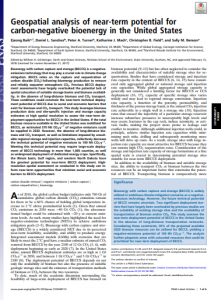Full Title: Geospatial analysis of near-term potential for carbon-negative bioenergy in the United States
Author(s): Ejeong Baik, Daniel L. Sanchez, Peter A. Turner, Katharine J. Mach, Christopher B. Field and Sally M. Benson
Publisher(s): National Academy of Sciences
Publication Date: February 1, 2018
Full Text: Download Resource
Description (excerpt):
Bioenergy with carbon capture and storage (BECCS) is a negative-emissions technology that may play a crucial role in climate change mitigation. BECCS relies on the capture and sequestration of carbon dioxide (CO2) following bioenergy production to remove and reliably sequester atmospheric CO2. Previous BECCS deployment assessments have largely overlooked the potential lack of spatial colocation of suitable storage basins and biomass availability, in the absence of long-distance biomass and CO2 transport. These conditions could constrain the near-term technical deployment potential of BECCS due to social and economic barriers that exist for biomass and CO2 transport. This study leverages biomass production data and site-specific injection and storage capacity estimates at high spatial resolution to assess the near-term deployment opportunities for BECCS in the United States. If the total biomass resource available in the United States was mobilized for BECCS, an estimated 370 Mt CO2⋅y−1 of negative emissions could be supplied in 2020. However, the absence of long-distance biomass and CO2 transport, as well as limitations imposed by unsuitable regional storage and injection capacities, collectively decrease the technical potential of negative emissions to 100 Mt CO2⋅y−1. Meeting this technical potential may require large-scale deployment of BECCS technology in more than 1,000 counties, as well as widespread deployment of dedicated energy crops. Specifically, the Illinois basin, Gulf region, and western North Dakota have the greatest potential for near-term BECCS deployment. High-resolution spatial assessment as conducted in this study can inform near-term opportunities that minimize social and economic barriers to BECCS deployment.
